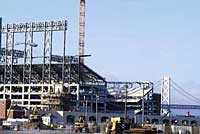Time to Go Private?
By Michael Khoo
November 9, 1999
Plans to build a new Minnesota Twins ballpark in downtown St. Paul collapsed last week when Capital City voters overwhelmingly rejected the idea. Rather than settle the issue, however, the ballot verdict raises questions about the future of the Twins. Many opponents of publicly-subsidized sports facilities argue the team should follow the lead of the San Francisco Giants and build a new ballpark with private money.
MAYOR NORM COLEMAN'S
plan for a new Twins ballpark in downtown St.
Paul would have used a mixture of city and state tax dollars to fund two-thirds
of the facility's construction costs. That deal is dead. And in the wake of last
week's voting, an alternative plan under consideration in Minneapolis and
Hennepin County remains stalled. Hennepin County Commissioner Peter McLaughlin
says there's no sense in offering competing proposals which continue to rely on
heavy subsidies.
By Michael Khoo
November 9, 1999
|
|
RealAudio 3.0 |
Plans to build a new Minnesota Twins ballpark in downtown St. Paul collapsed last week when Capital City voters overwhelmingly rejected the idea. Rather than settle the issue, however, the ballot verdict raises questions about the future of the Twins. Many opponents of publicly-subsidized sports facilities argue the team should follow the lead of the San Francisco Giants and build a new ballpark with private money.
| |
|
|
|
||
McLaughlin: Well I've been saying all along that, sort of, warmed-over versions of the same old deal of putting huge public tax subsidies into these things wasn't going to fly. And so I think this just reinforces that.McLaughlin didn't say how much of a stadium should by funded with private dollars in order to gain public approval. But Republican State Representative Ron Abrams of Minnetonka thinks he has the answer: all of it. Or at any rate, almost all of it. Abrams, who chairs the House Tax committee, points out the San Francisco Giants are building their new Pacific Bell Ballpark using 95 percent private funding.
Abrams: There certainly is nothing to prohibit the Twins or anybody else to put up a stadium using private funds. Additionally, the corporate community can step up if they believe that this is an amenity that's important to their businesses, help buy a new stadium through a variety of financing devices.Which is exactly what the Giants have done. After losing four ballot initiatives seeking public subsidies, the team -- under new ownership -- cobbled together a package of private financing unheard of in the recent stadium construction boom. Jack Bair is the senior vice-president and general counsel for the Giants.
Bair: Given the history of four failed elections, seeking a substantial public component to finance a new ballpark was likely to result in another lost election. So, we approached it differently.The Giants raised $65 million through the sale of Personal Seat Licenses, which give holders first rights to buy season tickets. Another $121 million came from stadium naming rights, concession contracts, and corporate partnerships. A small amount of public money came through tax-increment financing and is paying for infrastructure improvements in the ballpark neighborhood. The largest single piece of financing was a $170 million loan taken out by the team. But could it work in Minnesota? Not according to Twins president Jerry Bell.
Bell: We looked at that four years ago. That was our first thought, "Let's build our own ballpark." And we hired Arthur Andersen to do the economics on that and it just doesn't work. We have an example here in the Twin Cities where Marv Wolfenson and Harvey Ratner built the Target Center and bought the basketball team and found they couldn't afford both.And even the Giants aren't sure their success could be replicated elsewhere. The San Francisco market is more than twice the size of the Twin Cities. And Bair says the private financing assembled in San Francisco was dependent on the region's economic character.
Bair: I can't speak for the conditions in other communities. We faced our unique problem here in San Francisco and tried to fashion a solution that would work here. We also are blessed with having a community that is enjoyed great economic times and also is the home to many of the most successful companies: gateway to Silicon Valley. We have a very affluent population here. And so we've been successful were other communities might not be able to be successful.And others caution it's not clear that even the Giants will be successful. Robert Baade says the team's experiment in private financing is not yet over. Baade is a sports economist at Lake Forest College in Illinois. He says debt service on the $170 million loan could eat into players' salaries, making it difficult to compete against other teams who have received generous assistance in building new ballparks.
Baade: A lot of us in reviewing the Giants' contract, we were left scratching our heads. I couldn't see how all of this added up, so I think it still remains to be seen if there isn't going to be a public bail-out at some point. We'll see how all of this plays out. I think this is a work in progress and not an end of story thing.Baade, like Twins President Bell, says Twin Cities' residents should remember the Target Center before rushing to embrace private financing solutions. In the meantime, Pac Bell Ballpark opens next spring.

